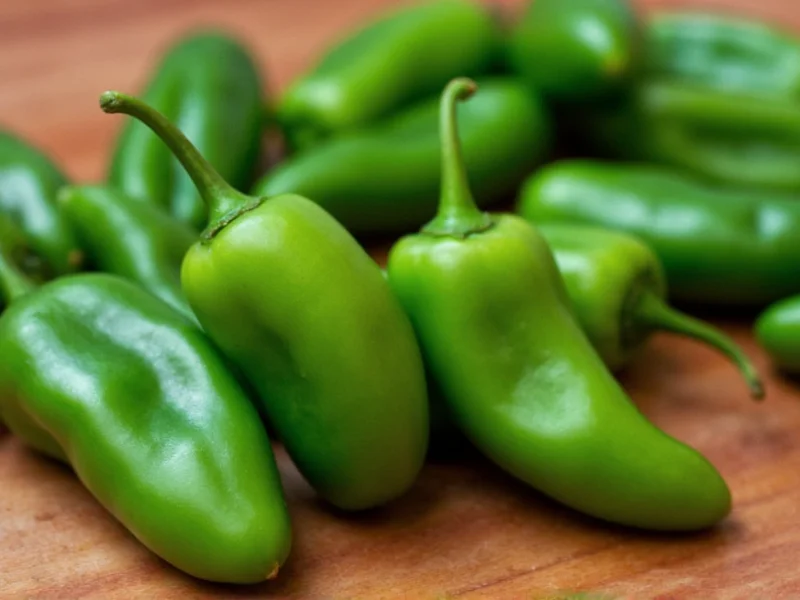Understanding the precise heat measurement of jalapeños is essential for both culinary applications and personal preference. The Scoville scale, developed by pharmacist Wilbur Scoville in 1912, remains the standard measurement for chili pepper pungency. This article explores the specific Scoville units of jalapeños, factors influencing their heat levels, and how they compare to other common peppers.
What Are Scoville Heat Units?
The Scoville scale measures the concentration of capsaicinoids—the chemical compounds responsible for the burning sensation in chili peppers. Originally determined through human taste testing, modern measurements use high-performance liquid chromatography (HPLC) for precise quantification. The resulting measurement is expressed in Scoville Heat Units (SHU), with higher numbers indicating greater heat intensity.
Jalapeño Heat Range Explained
While the standard jalapeño pepper heat level range falls between 2,500 and 8,000 SHU, several factors contribute to this variation:
- Ripeness: Green jalapeños (less ripe) tend to be milder than red jalapeños (fully ripe)
- Growing conditions: Soil composition, climate, and water availability affect capsaicin production
- Genetic variation: Different jalapeño cultivars have inherent heat differences
- Seed and membrane content: The placenta (white ribs) and seeds contain the highest concentration of capsaicin
Pepper Heat Comparison Chart
| Pepper Variety | Scoville Heat Units (SHU) | Heat Level |
|---|---|---|
| Bell Pepper | 0 SHU | Mild |
| Jalapeño | 2,500–8,000 SHU | Mild to Medium |
| Serrano | 10,000–23,000 SHU | Medium to Hot |
| Habanero | 100,000–350,000 SHU | Very Hot |
| Ghost Pepper | 855,000–1,041,427 SHU | Extremely Hot |
Factors Affecting Jalapeño Heat Intensity
Several environmental and biological elements influence why do jalapeños have varying heat levels. Stress factors actually increase capsaicin production as a defense mechanism for the plant. When jalapeño plants experience:
- Drought conditions
- Temperature fluctuations
- Nutrient deficiencies
- Pest pressure
...they often produce hotter peppers. This explains why two jalapeños from the same plant can have noticeably different heat levels—a phenomenon many home cooks have experienced.
Practical Implications for Cooking
Knowing the average Scoville units for fresh jalapeños helps cooks anticipate heat levels in recipes. For those seeking milder results when using jalapeños:
- Remove seeds and white membranes (where most capsaicin concentrates)
- Soak sliced peppers in salt water for 15-30 minutes
- Choose smooth-skinned, uniformly green jalapeños (wrinkled peppers often indicate higher heat)
- Use dairy products like yogurt or sour cream to counteract heat in finished dishes
Common Misconceptions About Jalapeño Heat
Several myths persist about measuring and experiencing jalapeño heat. Contrary to popular belief, the size of a jalapeño doesn't reliably indicate its heat level—small peppers can be mild while large ones can be surprisingly hot. Additionally, the heat sensation isn't immediate; capsaicin takes 30-60 seconds to fully register on your palate, which explains why people sometimes consume more than intended before feeling the burn.
Measuring Pepper Heat Accurately
While home cooks can't precisely measure Scoville units without laboratory equipment, understanding how jalapeños compare to other chili peppers provides practical context. The Scoville Organoleptic Test, though largely replaced by HPLC, established the relative heat comparisons we use today. When following recipes that specify jalapeños, remember that comparing jalapeño heat to other chili peppers helps adjust expectations—two jalapeños might equal one serrano in heat intensity, for example.
Conclusion
The Scoville units of a jalapeño pepper provide valuable information for culinary planning and personal preference. With their characteristic mild to medium heat range of 2,500–8,000 SHU, jalapeños offer versatility in cooking while remaining accessible to most palates. Understanding the factors affecting jalapeño heat intensity allows for better control in recipes, whether you're seeking subtle flavor enhancement or noticeable heat. As with all chili peppers, individual variation means tasting a small piece before committing to a recipe remains the most reliable approach to managing heat levels.
Frequently Asked Questions
What is the average Scoville unit measurement for a typical jalapeño?
The average Scoville unit measurement for a typical jalapeño falls between 2,500 and 8,000 SHU. Most commercially available jalapeños measure around 5,000 SHU, placing them firmly in the mild to medium heat category compared to other chili peppers.
Why do some jalapeños taste hotter than others?
Jalapeños vary in heat due to growing conditions, ripeness, and genetic factors. Stressors like drought or temperature fluctuations increase capsaicin production. Additionally, the seeds and white membranes contain the highest concentration of capsaicin, so peppers with more of these parts will taste hotter. Even jalapeños from the same plant can have different heat levels.
How does jalapeño heat compare to other common peppers?
Jalapeños (2,500-8,000 SHU) are significantly milder than habaneros (100,000-350,000 SHU) but hotter than bell peppers (0 SHU). They're about 2-9 times hotter than poblanos (1,000-2,000 SHU) and about 3-8 times milder than serranos (10,000-23,000 SHU). This moderate heat level makes jalapeños versatile for various culinary applications.
Can I reduce the heat of jalapeños before using them in recipes?
Yes, you can reduce jalapeño heat by removing the seeds and white membranes (placenta), which contain the highest concentration of capsaicin. Soaking sliced jalapeños in salt water for 15-30 minutes can also draw out some heat. For cooked dishes, adding dairy products like yogurt or sour cream after cooking helps counteract the heat sensation.
Do red jalapeños have different Scoville units than green ones?
Yes, red jalapeños (fully ripe) typically measure higher on the Scoville scale than green jalapeños (less ripe). As jalapeños mature and turn red, they often develop more capsaicin, resulting in heat levels toward the upper end of the 2,500-8,000 SHU range. Red jalapeños also develop sweeter flavor notes alongside increased heat.











 浙公网安备
33010002000092号
浙公网安备
33010002000092号 浙B2-20120091-4
浙B2-20120091-4